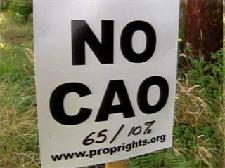|
Land-use wars brewing in rural King County Tuesday, July 20, 2004
SEATTLE, WA- An ordinance that would keep some rural King County landowners from using more than half their property brought scores of them to Seattle Tuesday. And they were angry. "This is more an issue of confiscation than compensation," Vashon Island resident Larry Defazio told a committee of the King County Council considering the measure. "I'm rather appalled that our county government … (is) so willing to use rather coercive and extortionist tactics to implement what may or may not be good environmental policy," Defazio said. At issue are changes proposed by King County Executive Ron Sims to the county's Critical Areas Ordinance, a part of the Growth management Act. Among other things, the changes would force rural property owners to leave 65 percent of their land forested or covered with vegetation. Only 35 percent could be cleared and buildings and other impervious surfaces could not cover more than 10 percent of the property. It is the first significant change to the critical areas ordinance in 14 years and could make the county's efforts to protect the natural environment the most restrictive in the nation, extending restrictions across the entire rural landscape. The changes are strongly supported by environmental groups, whose
members say they are needed to keep the region's water supply clean
and safe and may also do a much to prevent sprawl and preserve the
habitat for plants and animals. Critical Areas Ordinance No CAO Web site 1,000 Friends of Washington "If we don't take action now, the cost to all of use will be greater down the road," Seattle resident Amy Souers told the County Council's Growth Management Committee. But angry landowners complained that there was little public notice about the rules, which, if enacted, will amount to a land taking for which they get no compensation. Edwina Johnston, 70, and her husband own 30 acres near the Preston, Fall City border. The couple bought the land in 1977 and had been planning to develop the land to support their retirement. But Johnston fears that the two small streams the run through the property and the changes being considered will seriously deflate the value of her nest egg. "If this land is taken from me, I am homeless when I can no longer work," she said. "Since the Comprehensive Plan is for the ostensible benefit of all of the people and all of the areas of King County, then all of the millions of taxpayers should share the cost of this plan instead of the far fewer number of affected property holders." Johnston found sympathy from some ordinance supporters on her last point. Sustainable Fisheries representative John Lombard said that without funding for rural property owners and incentives to follow the law, all the anguish over the ordinance would be for naught. Healy, of the 1,000 Friends Group, said he didn't think the ordinance was unfair to property owners. "Is it fair for those people to be able to build on their land in a way that jeopardizes the health of the broader community?" Healy asked. "It will ensure that the natural environment has the ability to do its job in providing healthy streams and rivers and clean water," said John Healy, communications director for 1,000 Friends of Washington. The restrictions are certainly not the first to confront rural landowners. The state Growth Management Act demands that counties use the "best available science" to protect critical areas such as streams, wetlands and steep slopes. But the science behind the new regulations -- which would extend protections across the entire rural landscape -- is also under fire. "The county, because of their political agenda, thinks that "the best science" means the most restrictive," Johnston said. KING 5's Gary Chittim contributed to this report.
|
 *
*